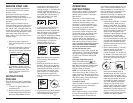
6
7
3. Combination Natural Pressure
Release and Quick Pressure Release
– For some recipes, we have chosen
to use a combination of Natural
Pressure Release and Quick Pressure
Release. Allow Natural Pressure
Release for the time indicated in the
recipe (food will continue to cook
slightly) followed by Quick Pressure
Release.
WARNING: USE EXTREME CAUTION
WHEN RELEASING PRESSURE. USE
TONGS OR SIMILAR UTENSIL TO
PULL HANDLE OF PRESSURE LIMIT
VALVE FORWARD.
When the red float is completely down,
turn the lid clockwise and lift to remove.
PRESSURE COOKER
SETTINGS
1. Low Pressure
2. High Pressure
3. Browning –
This preset
temperature allows
cooking over high
heat, without the
lid, before pressure
cooking. Browning
foods in a small
amount of fat in
this way seals the
outer surfaces of
meats and
vegetables,
producing a
visually appealing, flavorful exterior
with a moist, tender interior.
4.
Sauté – The preset temperature,
done prior to pressure cooking with
lid removed, allows you to quickly
soften vegetables in a small amount
of fat or liquid without browning, and
to cook items such as rice (Arborio,
brown, Carnaroli, white, etc.) for
pilafs and risottos.
5.
Simmer – This preset temperature
allows you to cook liquids at a lower
temperature. It is primarily used to
finish cooking some items, i.e. to add
ingredients to a risotto, sauce, or
stew or to continue cooking process
to achieve preferred texture.
6.
Keep Warm – Holds and keeps
cooked food warm for up to 12 hours
(see next page).
SAFETY VALVES
There are seven safety devices installed
in the pressure cooker to assure its
reliability.
1.
Open-and-Close Lid Safety Device
The appliance will not start
pressurizing until the lid is closed and
locked properly.
The lid cannot be opened if the
appliance is filled with pressure.
2. Pressure Control Device
The correct pressure level is
automatically maintained during the
cooking cycle.
3.
Pressure Limit Valve
The pressure limit valve will release
air automatically when the pressure
inside exceeds the preset
temperature.
4.
Anti-Block Cover
Prevents any food material from
blocking the pressure limit valve.
5.
Pressure Relief Device
When the pressure cooker reaches
the maximum allowable pressure and
temperature, the cooking pot will
move down until lid separates from
the sealing ring, releasing air
pressure.
6.
Thermostat
The power will automatically shut off
when the cooking pot temperature
reaches the preset value, or the
pressure cooker is heating without
any food inside.
7.
Thermal Fuse
The circuit will be opened when the
pressure cooker reaches the
maximum temperature.
CLEANING
1. Unplug the power cord before
cleaning.
2. Clean the outer body with a soft cloth
such as a paper towel or microfiber
cloth. Do not immerse the outer body
in water or pour water into it.
3. Rinse with warm water the underside
of the lid including the sealing ring,
pressure limit valve, anti-block cover,
air escape and float valve. Dry
completely.
4. Clean area under upper ring with
dampened cloth or micro fiber cloth.
Do not use chemical cleaners.
5. Cooking pot is dishwasher-safe. To
hand-clean the cooking pot, use a
soft cloth or sponge and wipe. Be
careful not to damage the inside
coating. Never use harsh chemicals
or scouring pads.
6. To clean sealing ring, hold the knob
on the sealing ring supporting cover
and pull the sealing ring up. After
cleaning, put the sealing ring
supporting cover back.
Note: The side with the knob should
face outward. Do not put it upside
down (figures 7 and 8).
7. To clean rubber grommet located in
center of sealing ring supporting
cover, carefully remove the sealing
ring supporting cover and clean the
grommet, then replace it.
8. To clean the pressure limit valve,
remove and rinse it
with water, then
replace it (figure 9).
9. To clean the condensation collector,
remove and clean it with warm soapy
water, then reinstall it.
TROUBLESHOOTING
Symptom Possible Reasons Solutions
Lid does not lock
The ring is not properly installed
The float is seized by the push rod
Reinstall the ring
Push the rod with hands
Cannot open the lid after air
exhaust
The float is still up Press the float down
Air escapes from the rim of
the lid
No sealing ring was installed
Food residue on sealing ring
Sealing ring worn out
Lid not locked properly
Install the sealing ring
Clean sealing ring
Replace the sealing ring
Rotate lid fully
Air escapes from the float
valve
Food stuck on the sealing ring of
the float valve
The sealing ring on the float wore
out
Clean the sealing ring
Replace the sealing ring
The float will not rise
The pressure limit valve is not
placed properly
Not enough food and water
Air escaping from the rim of the
lid and the pressure limit valve
Place the device to Pressure
Check recipe for proper quantity
Call our Consumer Service Center
toll free at 1-800-726-0190
(9)
Condensation
Collector
(7)
(8)







